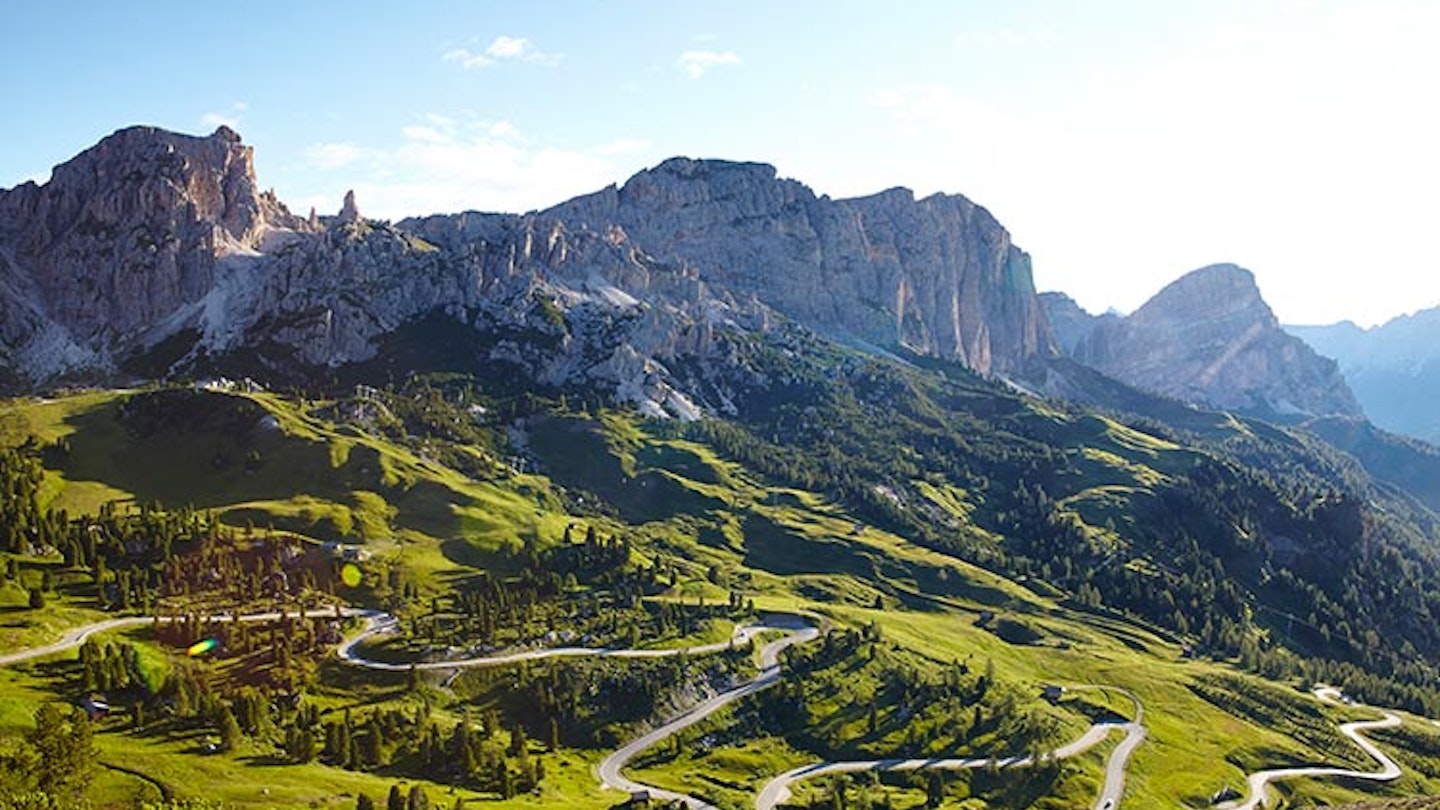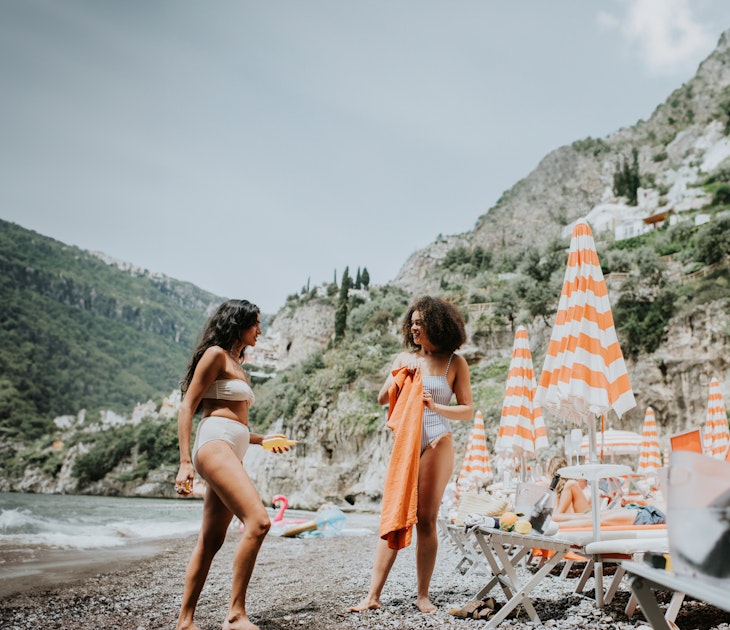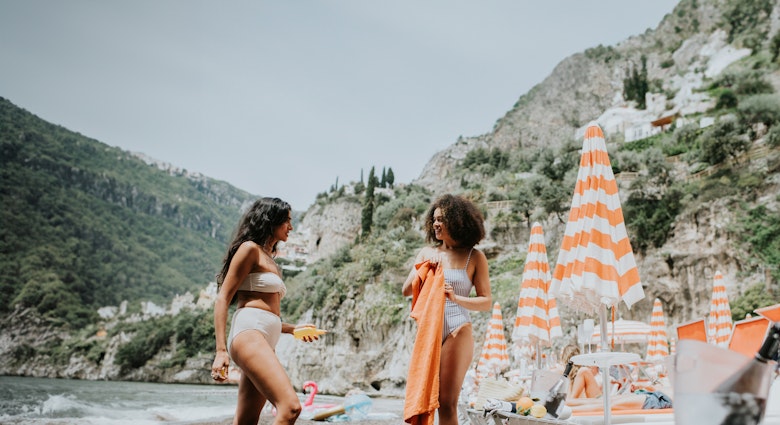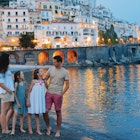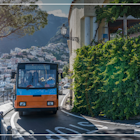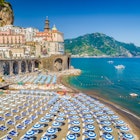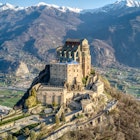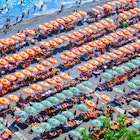It’s the season to enjoy la dolce vita, whether driving the Amalfi Coast, watching the sunrise in Venice or tracking down the best gelato in Sicily. Straight from Lonely Planet Traveller magazine's new-look July edition, here are the best experiences under the Italian sun.
Image by Matt Munro / Lonely Planet Traveller
1. Take a stroll in the Südtirol
The Dolomites might not be the tallest summits in the Alps, but they’re arguably the most impressive: limestone chunks eroded into vertical precipices, rising sheer from a forested valley floor. Set out on a summer hike in their shadow and you’ll see a corner of Italy quite unlike any other: Alpine meadows full of wildflowers and grazing cattle, huts serving wursts and strong beer, German-speaking villages – a place more reminiscent of Bavaria than Bologna. To see it at its most impressive, follow the trails of Val di Funes – where the Odle mountains bear down menacingly over the tiny church of Santa Maddelena – before driving south along majestically wiggly mountain passes to Val Gardena. To make matters even more confusing, locals here speak yet another tongue: Ladin, an ancient Romance language of just 20,000 speakers, preserved over centuries by the steep mountains all around.
Make it happen: the Hotel Tyrol in Val di Funes has rooms with views of the Odle mountain range. You can practise both your Italian and your German on the staff (tyrol-hotel.eu). Perched at the top of the Gardena pass, Jimmy Hütte serves sturdy Südtirolean food, including excellent speck – juniper-cured ham (jimmyhuette.com).
2. Drive along the Amalfi Coast
Italy has a reputation as a place where even B-roads are treated like Silverstone. This slightly unfair preconception puts many people off driving here – a shame considering that Italian asphalt is home to some of Europe’s greatest road trips. The grandfather of them all is officially known as Strada Statale 163 and unofficially as the Amalfi Coast drive – a sublime 35-mile route along the coast of the Sorrento Peninsula, whose hairpin bends and nerve-shredding cliff-edge slaloms bring out every motorist’s inner Formula 1 driver. On the way you’ll pass green hills rising from a balmy sea, fishing villages built at 45-degree angles and ancient monasteries high in the cliffs. Start in Salerno, stopping by at the 11th-century cathedral to pray for safe passage on the road ahead. Heading west, the windiest sections arrive after Amalfi – a small town once home to a medieval seafaring empire. Take a detour up the hill to Ravello, where Wagner once found inspiration for his pure, noble knight Parsifal; DH Lawrence also stayed and found inspiration for his rather less pure heroine Lady Chatterley. A spectacular stretch of road wiggles among olive groves and tiny bays to Positano, before heading across the peninsula to reach Sorrento.
Make it happen: Park up at the Hotel Lidomare in Amalfi for antique-furnished rooms, many with balconies and sea views (lidomare.it). Facing the beach in Amalfi, Marina Grande offers simple local seafood and homemade pasta dishes (ristorantemarinagrande.com).
The Amalfi Coast has been a glamour hotspot ever since Jackie Onassis, Sophia Loren and Brigitte Bardot came here in the late ’50s. Image by Mark Read / Lonely Planet Traveller
3. See Venice at first light
Something about staying in Venice induces long, languorous lie-ins. Perhaps it’s the Adriatic air; maybe it’s the sound of water lapping against the foundations of your hotel. Either way, it means that most visitors to Italy’s most beautiful city wake up only after its thoroughfares are clogged with tourists. Follow the example of the city’s bin men and you won’t fall into such a trap. Every day they cast off in their bin boats in the pre-dawn light, sailing through an empty city few others get to see – a place of silent and deserted piazzas, towers and spires illuminated in soft morning light. To see the city the way they do (minus the unpleasant smells), pack a loud alarm clock and rise well before dawn – in July sunrise is around 5.40am. Begin with the busiest tourist bottleneck – St Mark’s Square – likely empty but for bin men and perhaps some pigeons, then proceed to the Rialto Bridge and potter through the ancient San Polo district, passing the Rialto market, where traders should soon be arriving for the day’s work. The first train arrives at Santa Luca station around 5.30am and crowds gradually filter eastwards as the day goes on: so beat them by heading to the leafy eastern district of Castello and the battlements of Venice’s Arsenale dockyard.
Make it happen: The Pensione Accademia occupies an old mansion near the Grand Canal (pensioneaccademia.it). In a San Polo backstreet, Caffé del Doge is perfect for an early cup of coffee (caffedeldoge.com).
4. Discover Sicilian ice cream
Ice cream consumption is an art form in Italy: the Italians are masters of eating the cone gracefully without depositing a bomb of icy goo on to the groin. There is even an ice cream university in Bologna. So it might come as a surprise that the frozen dessert wasn’t devised by Italians at all.
Folklore relates how Arab conquerors introduced the concept to Europe via Sicily in the 9th century – a way of cooling down on sweltering summer days. A thousand summers later and nowhere has this love affair endured more fruitfully than in Taormina, the medieval east-coast town long famed as a seaside resort for aristocrats and monarchs. Similarly well bred are its gelaterias – O’Sciality has a wide selection, from popular stracciatella (Italian chocolate chip) to obscure species like ricotta and pear – or drop by Bam Bar for traditional Sicilian granita, close to the town’s Greek theatre. Ice cream in hand, potter down to the shore for a paddle beside the pint-sized island of Isola Bella. Alternatively stroll the terraces for views up to Mount Etna, the volcano from whose chilly heights the ice for the first Sicilian ice creams was harvested a millennium ago.
Make it happen: Bed down at Isoco Guest House in Taormina – each flamboyantly decorated room is dedicated to a famous artist (isoco.it). O’Sciality is off Sant'Antonio Abate square in central Taormina (osciality.it).
More than 50 per cent of Italians slurp an ice cream every week. Image by Matt Munro / Lonely Planet Traveller
5. Savour produce in Piedmont
Food is a serious issue in Italy, but in the Langhe valley it’s especially serious – perhaps because of rivalry with French chefs over the border; maybe because of the embarrassment of riches it’s blessed with year-round. In autumn, truffles are gathered from its oak forests; in spring, snails awake from hibernation to find themselves served on dining plates. In summer, fresh fruit and veg is abundant and the region is at its most lovely, with hillside towns rising photogenically from a sea of flowering vineyards. One of them is Barolo – a hub for vineyard tours – whose namesake wine is the so-called ‘king of Italian reds’. It was once deemed so precious that anyone caught stealing its grapes was rewarded with amputation. Be sure to keep your limbs attached so you can drive onward to the dapper terracotta town of Alba – home to a small constellation of Michelin-starred restaurants. For summery Piedmontese food try La Piola in the town centre. Lunches comprise carpaccios, stuffed seasonal vegetables and pairings with local wines – best consumed at a leisurely tempo over long afternoons as the shadows lengthen in the square outside.
Make it happen: The Hotel Barolo has comfortable rooms and a terrace overlooking Barolo’s medieval castle (hotelbarolo.it). La Piola serves traditional Piedmontese food in Alba. Try vitello tonnato – a local summer dish of sliced veal flavoured with tuna (lapiola-alba.it).
Mergozzo lies on the western shore of the lake – a ban on motorboats preserves the peace. Image by Andrew Montgomery / Lonely Planet Traveller
6. Find the Italian Lakes’ quiet side
You know you’ve made it in Italian society when you buy a home on the lakes. Roman dignitaries built their villas here, Milanese aristocracy built palaces, and Silvio Berlusconi bought a house so he could bunga-bunga beside the waters of Lake Como with the snowy splendour of the Alps rising above him.
Chances are you won’t be able to afford a discreet pad, but you can at least hope to find a quiet spot of your own during the high season scrum by venturing away from the bigger lakes. Try Lake Mergozzo – something of a puddle compared to Garda and Como – but certainly a more peaceful affair, with speedboat-free waters and swans sometimes outnumbering tourists. Visit its sleepy namesake village – with pastel-coloured houses set along a natural amphitheatre on the northern shore – or climb the quiet hillside lanes behind the village for views of glamorous Lake Maggiore on the horizon. Mergozzo was once part of the same lake, but the channels silted up centuries ago, and she opted to go it alone for a quieter life.
Make it happen: Le Oche di Bracchio is a lemony yellow B&B set in tidy gardens outside Mergozzo, with views of Lake Maggiore in the distance (leochedibracchio.com). La Piemontese serves old-school dishes like fried snails and duck confit in Stresa, a 10-minute drive from Mergozzo (ristorantepiemontese.com).
Vieste, the main town in the Gargano region, faces the Adriatic from atop its limestone cliffs. Image by Matt Munro / Lonely Planet Traveller
7. Find a secret Sardinian beach
Most of the year Sardinia’s beaches are rather quiet affairs. Every summer, however, they undergo a Dr Jekyll-esque transformation into Italy’s foremost sunbathing spot: a D-Day-scale invasion of parasols, towels and heaving flesh from the Italian mainland. Yet by some miracle, many of the finest beaches are also the quietest. To leave the crowds behind, set out for the Golfo di Orosei halfway up the east coast: mighty walls of rock rise from the sea with quiet beaches hemmed in among them – quiet precisely because many are accessible only by boat. Boarding at the town of Cala Gonone, boats putter south past the Grotto del Bue Marino – a stalactite-studded cave popular with seals. Sailing south of here, the finest beaches swing into view: Cala Sisine – a long stretch of white sand fringed by chalky hills – and Cala Mariolu, where brilliant blue waters lap against a pebbly beach. Nuovo Consorzio Trasporti Marittimi offers return trips to all the islands along the coast – miss the boat home and, for better or for worse, you might find yourself marooned.
Make it happen: Nuovo Consorzio Trasporti Marittimi offers return trips to Cala Sisine and Cala Mariolu (calagononecrociere.it) from Cala Gonone. Agriturismo Nuraghe Mannu has accommodation in the hills above the town of Cala Gonone – the restaurant serves homemade cheeses and home-reared lamb (agriturismonuraghemannu.com).
8. Learn Bologna’s culinary rules
Bologna is both a culinary and academic capital – a home to boisterous cafés and the world’s oldest university, a place especially radiant in summer when parasols unfurl on the pavements and wise professors seek respite in the city’s shady colonnades. In this spirit of learning and scoffing, it’s the perfect place to understand the complex rules governing Italian eating and drinking. Begin the day with a robust coffee outside one of the cafés set off the grand square, Piazza Maggiore – the smart, minimalist Caffe Terzi is a good choice. Work up an appetite with a saunter around Bologna’s cobbled medieval core, scouting out a suitable spot for lunch. Bolognese sauce is the city’s greatest gift to the global larder – but asking for ‘spag bol’ will summon the food police on speed dial. Tagliatelle al ragù is the true Italian version; sample it on the terrace at the Trattoria del Rosso – a no-frills outfit said to be the oldest restaurant in the city. Italian tradition demands you should only drink wine or water with meals: soft drinks will earn you frowns.
Make it happen: Close to Piazza Maggiore, rooms at Albergo Centrale feature parquet flooring and tall windows, and a pastry-heavy breakfast buffet (albergocentralebologna.it). Trattoria del Rosso, off Piazza dell’8 Agosto, serves value lasagnes, tortellini and tagliatelle (trattoriadelrosso.com).
Bologna’s Piazza Maggiore, flanked by Renaissance mansions. Image by Matt Munro / Lonely Planet Traveller
9. Walk the Roman passeggiata
Every summer evening, like clockwork between 5pm and 7pm, thousands of Italians empty on to streets, from Palermo to Padua, to indulge in the daily ritual of passeggiata (‘the little walk’). To describe passeggiata as an evening amble is to do it a disservice: to some it’s a way of getting outside after the heat of a summer’s day; to others a means of working up an appetite before dinner; to most it’s a cleverly contrived way of bumping into friends and acquaintances. Passeggiata can take any form – the only criteria is that you must saunter in leisurely fashion and dress fairly smartly.
In Rome, a popular route follows Via Del Corso north to the Piazza del Popolo – passing under the long shadow of the Egyptian obelisk at the centre of the square – before ascending stone steps to the Pincian Hill. At the top, public gardens are shaded by tall pines and swaying palms, with solemn classical statues and ponds full of paddling terrapins. More impressive than all this, however, is the view: a prospect over rooftops, domes and towers into the Roman sunset, with the silhouette of the Vatican rising in the distance. For a quieter but equally magnificent view, take a passeggiata up leafy boulevards to the Janiculum Hill, south of the Vatican: standing at the top, you’ll see the city skyline framed by the leafy mass of Rome’s botanical gardens. From here, it’s an easy amble downhill to osterias and trattorias among the rambling streets of the Trastevere district, ending your passeggiata the time-honoured way: with a long, lazy, al-fresco dinner.
Make it happen: Arco del Lauro is a six-room guesthouse set in a 16th-century palazzo in Trastevere. Whitewashed rooms have beamed ceilings (arcodellauro.it). Set in a Trastevere backstreet, Meridionale serves southern Italian dishes such as spaghetti with squid. Book early to get an outside table overlooking the street (meridionaletrastevere.com).
10. Sail the Puglian coast
The Promontorio del Gargano is a smaller, rather warmer Italian lookalike of the White Cliffs of Dover – with chalky coloured precipices bulging out into the Adriatic. This landmass was once connected to what is now Croatia: many aeons ago it defected to Italy and as long since been crowned by the seafaring town of Vieste – a huddle of whitewashed houses, meandering Arabesque alleys and a grand lighthouse presiding over the harbour. The town beaches can get rather busy in high summer, but the surrounding coastline (both north and south of town) stays quiet – other than croaking crickets and gently lapping tides. To get there, make for the town’s port: Centro Ormeggi e Sub leases out boats of various shapes and sizes by the hour or by the day. Set a course south, and within a few minutes you’ll find yourself along the shores of the Parco Nazionale del Gargano, a reserve where the forests are home to roving deer and wild cats, and copses of Aleppo pine and oak reach right down to the coastal coves. Return to Vieste in the late afternoon, welcomed home by the sight of white cliffs rearing out of the sea.
Make it happen: Centro Ormeggi e Sub leases out motorboats and sail boats from Vieste – with vessels ranging from 5m to 12m (vieste.it). Hotel Seggio has spacious rooms in a 17th-century palazzo: the restaurant serves Puglian dishes with a gorgeous sea view (hotelseggio.it).
To read more on summer in Italy, get the new-look July issue of Lonely Planet Traveller magazine, on sale now.
For UK readers, get five issues for just £5 when you subscribe today – CLICK HERE.
